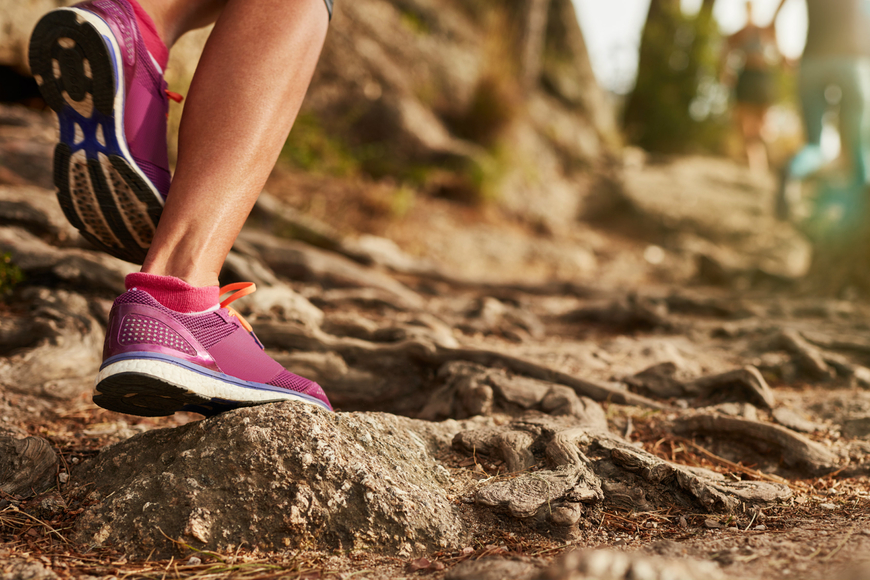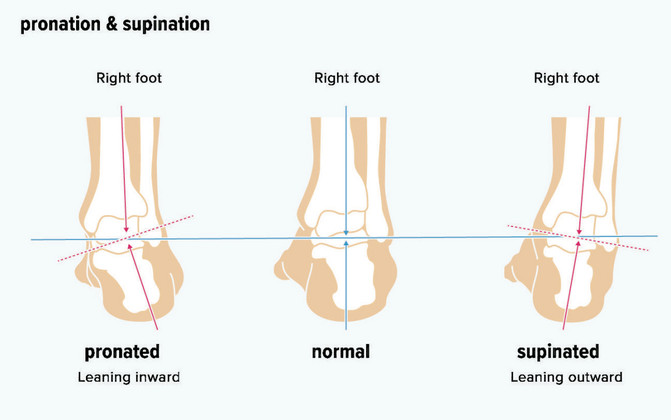All About Running Shoes

With the weather finally warming up, everyone is getting outside and running! Hooray! But unfortunately, injuries are common after a winter of limited activity. How can we avoid these injuries? In addition to following the recommendations from Nina's blog on knee pain with running (go read that too!), something that is often overlooked are your shoes!
Why are shoes important?
With every step of your running gait, you put over 3 times your body weight onto your lower extremity. Your feet are the initial shock absorbers and therefore, so are your shoes. The amount of force exerted onto your feet travels all the way up the kinetic chain, which is a term for how your whole body works together to produce motion. In order to minimize stress on not only your feet but your ankles, knees, hips, lower back, etc., you need the proper support. Every runner is different and has their own unique needs in their proper shoe.
Well, what shoes are right for me?
The best type of shoe will be one that fits YOUR foot anatomy and is COMFORTABLE! None of the below tips matter if your shoes don’t fit. Unless you are familiar with the brand, it’s important to try on shoes to get the appropriate size because they can differ from company to company (for example, an 9 in brand A may be similar to an 8 ½ from Brand B). A proper fitting shoe will not only be the most comfortable, but also provide you with the most support and stability during activity.
Things to think about:
Where will you be running? In order to conquer whatever terrain you will be running on, you need the proper type of shoe to provide comfort and stability:
- Road runners - Meant for people running on treadmills or asphalt, occasionally going on gravel or uneven surfaces. These shoes are generally lighter and flatter to help give more of a consistent run.
- Trail runners - These are more meant for people who run off road or on hiking trails. These shoes have grippier soles to prevent falls, and they offer more stability than traditional running shoes.
- Cross Trainers - Meant for those who do a little bit of everything, and are good for workouts in the gym as well.
- Minimalistic or “Toe Shoes” - These are meant for people who prefer minimalist barefoot running but still want protection for their feet. While a good choice for those who prefer that, there is no clinical evidence supporting increased performance or decreased injury rates compared to “normal” running shoes.
Shoe Construction
Cushioning, how “squishy” the shoe feels” is very important in choosing a comfortable running shoe. These range from maximal support (very cushiony) to minimalistic (very little support with almost no material between you and the ground). What you choose will depend on your running style and again, what is comfortable.
Running Style
Depending on your type of activity and running style, you want a shoe that will give you the most comfort where you strike the ground first. The 3 most common running styles are:
- Forefoot Striking: Landing right below the toes at the top of your feet. Common in sprinters and hill-runners.
- Midfoot Striking: The most common type of trained runner, landing with your whole foot but the majority of weight going around the arch, a little below the ball of the foot.
- Heel Striking: Landing on your heel and rolling through your whole foot with each step. Common in power walkers and long distance runners.
Arches
The arch in your foot is the initial shock absorber everytime you step down onto the ground, so it’s important to support it as much as you can. The foot arch is a complex relationship of many muscles, bones, and other soft tissues in your foot and ankle complex. Depending on the type of arches you have in your feet will greatly impact on which shoes you buy, and if orthotics are necessary. There are generally 3 types:
- Pronation: Also known as “flat feet”, your ankle and foot collapses and rolls inward, putting more pressure on the inside. Generally shoes focusing on medial stability are recommended.
- Neutral: Weight is evenly distributed between the inside and outside of the foot, with no excessive ankle inversion (rolling out) or eversion (rolling in).
- Supination: Opposite of pronation, your foot is more likely to roll outward and you have a high inside arch. Shoes emphasizing support for the arch are recommended.

So, should I get orthotics?
Many running shoes do not come with very good insoles so a pair of orthotics can be a worthy investment, especially if you have a history of injuries or know you over-pronate or over-supinate. More information can be found in a previous blog post or on our Custom Orthotics page.
When to say goodbye (and get new shoes)
So alright, say you’ve had a great pair of shoes for awhile now. The thing is, shoes can wear out a lot sooner than you’d expect, and running on old shoes won’t give you the support that you need, meaning:
A. you won’t perform as well and
B. it potentially could lead to injuries.
Here are some tips on when to get new shoes:
Mileage
It’s important to track your mileage. Generally, it’s recommended that running shoes are changed about every 500 miles. While it’s not a set in stone number, it’s generally a good guideline. On average, unless you are a very dedicated long distance runner who racks up a lot of miles, you can estimate changing your shoes every 3-5 months depending on how often you use them.
Wear and Tear
For obvious reasons, if there is damage to the shoe (like loops for the laces are blown out or there are holes revealing your socks), it’s probably time to say goodbye. While I’ve certainly used duct tape to hold cleats together, running on any shoe with damage is not ideal for long term foot health.
Tread Patterns
Grab your running shoes and take a look underneath at the tread. You may notice that certain areas are more worn down than others (especially because everyone’s running gait is a little different, think toe/forefoot strikers vs. heel strikers). A little wear and tear is okay, but if it seems that areas are eroded so much that it’s changing the shape of the tread then it’s time to change pairs. NOTE: This ESPECIALLY applies if you notice one shoe is more worn than the other; this imbalance can either be indicative of biomechanical differences on each side of your body, or lead to them down the road.
While not a definitive guide, this blog should give you a good idea on what to look for when trying to find the “perfect shoe” and when it’s a good idea to switch them out. If at any point you’re unsure about your running gait or what shoes are right for your feet, you can schedule an injury screen or gait assessment at any of our clinics.


